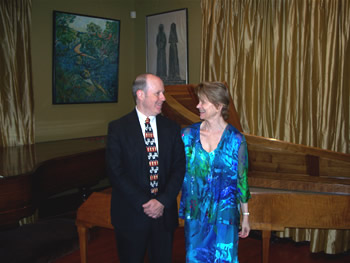This preview has been provided by Baroque and Beyond.
Wood and leather against string – the hammers of early pianos are remarkably different from the plump, felt-covered oval hammers of the modern piano. And the sound is remarkably different – some say better.
Not that Baroque & Beyond’s Artistic Director Beverly Biggs doesn’t love the modern piano. It was, after all, her first instrument and its repertoire still makes her heart sing. But along the way, she was seduced by other sounds and musical sensibilities. First, the harpsichord, with its crisp pluck and (particularly with French harpsichords) the deep, rich sonorities. Then later, by the early fortepiano, with its smaller keys, strong fortissimo, and utterly magical pianissimo.
When Baroque & Beyond opens its season on October 14, listeners will hear not one, but two fortepianos. Bev’s instrument is a replica of an original by Andreas Stein from 1784. John O’Brien’s instrument is a replica of an original by Anton Walter from 1782. In the late 1700’s, fortepianos were made by hand. As a result, no two instruments are alike. (http://en.wikipedia.org/wiki/Fortepiano#Viennese_school_of_builders). Bev and John have programmed a sonata for two fortepianos by Dussek that offers ample opportunity to appreciate the similarities and differences between their instruments.
Jan Ladislav Dussek (1760-1812) was a Czech composer and pianist. He was an important representative of Czech music abroad in the second half of 18th century and the beginning of 19th century. Dussek was one of the first piano virtuosos to travel widely throughout Europe. He performed at courts and concert venues from London to St. Petersburg to Milan, and was celebrated as a performer.
The Dussek family history as professional musicians extends from the early 1700’s at least until the 1970’s. Jan Ladislav apparently did not make his family very proud with his school report cards. Poor grades followed him from his early years through his enrollment at the University of Prague, where he lasted one semester. In spite of this, he clearly acquired both a solid musical education and considerable technical prowess as a performer. His biography on Wikipedia (http://en.wikipedia.org/wiki/Jan_Ladislav_Dussek) paints a picture of a colorful but chaotic personal life, during which his equally colorful career unfolded. His Sonata in F major, Op. 26, was first performed in London in 1790.
Other performers are John Pruett, violin, and Stephanie Vial, cello. The group will play works in various combinations – including a trio by Haydn, a cello sonata by Beethoven, and a violin sonata by Mozart.
Single tickets are $18, available at the door, or in advance by mail from the Preservation Society of Chapel Hill (610 E. Rosemary Street, Chapel Hill NC 27514). Series tickets for all three 2012-13 concerts are $50.
Parking is available in the Rosemary Street Parking deck, in the Planetarium parking lot, and sometimes on nearby streets.











